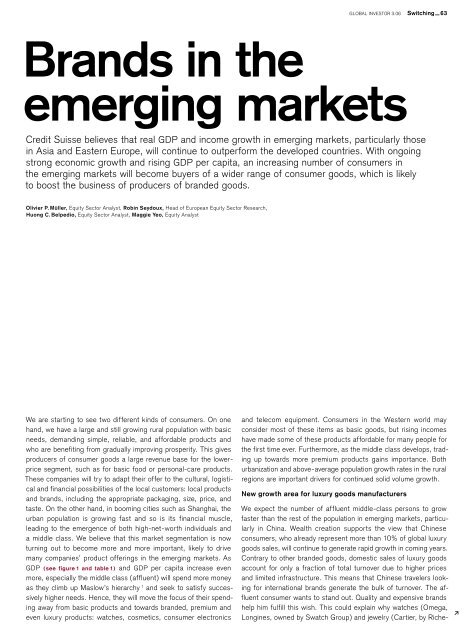Banking for 7 billion and 7 million
New challenges and opportunities of globalization Global Investor, 03/2006 Credit Suisse
New challenges and opportunities of globalization
Global Investor, 03/2006
Credit Suisse
You also want an ePaper? Increase the reach of your titles
YUMPU automatically turns print PDFs into web optimized ePapers that Google loves.
GLOBAL INVESTOR 3.06 Switching — 63<br />
Br<strong>and</strong>s in the<br />
emerging markets<br />
Credit Suisse believes that real GDP <strong>and</strong> income growth in emerging markets, particularly those<br />
in Asia <strong>and</strong> Eastern Europe, will continue to outper<strong>for</strong>m the developed countries. With ongoing<br />
strong economic growth <strong>and</strong> rising GDP per capita, an increasing number of consumers in<br />
the emerging markets will become buyers of a wider range of consumer goods, which is likely<br />
to boost the business of producers of br<strong>and</strong>ed goods.<br />
Olivier P. Müller, Equity Sector Analyst, Robin Seydoux, Head of European Equity Sector Research,<br />
Huong C. Belpedio, Equity Sector Analyst, Maggie Yeo, Equity Analyst<br />
We are starting to see two different kinds of consumers. On one<br />
h<strong>and</strong>, we have a large <strong>and</strong> still growing rural population with basic<br />
needs, dem<strong>and</strong>ing simple, reliable, <strong>and</strong> af<strong>for</strong>dable products <strong>and</strong><br />
who are benefiting from gradually improving prosperity. This gives<br />
producers of consumer goods a large revenue base <strong>for</strong> the lowerprice<br />
segment, such as <strong>for</strong> basic food or personal-care products.<br />
These companies will try to adapt their offer to the cultural, logistical<br />
<strong>and</strong> financial possibilities of the local customers: local products<br />
<strong>and</strong> br<strong>and</strong>s, including the appropriate packaging, size, price, <strong>and</strong><br />
taste. On the other h<strong>and</strong>, in booming cities such as Shanghai, the<br />
urban population is growing fast <strong>and</strong> so is its financial muscle,<br />
leading to the emergence of both high-net-worth individuals <strong>and</strong><br />
a middle class. We believe that this market segmentation is now<br />
turning out to become more <strong>and</strong> more important, likely to drive<br />
many companies’ product offerings in the emerging markets. As<br />
GDP (see figure 1 <strong>and</strong> table 1) <strong>and</strong> GDP per capita increase even<br />
more, especially the middle class (affluent) will spend more money<br />
as they climb up Maslow’s hierarchy 1 <strong>and</strong> seek to satisfy successively<br />
higher needs. Hence, they will move the focus of their spending<br />
away from basic products <strong>and</strong> towards br<strong>and</strong>ed, premium <strong>and</strong><br />
even luxury products: watches, cosmetics, consumer electronics<br />
<strong>and</strong> telecom equipment. Consumers in the Western world may<br />
consider most of these items as basic goods, but rising incomes<br />
have made some of these products af<strong>for</strong>dable <strong>for</strong> many people <strong>for</strong><br />
the first time ever. Furthermore, as the middle class develops, trading<br />
up towards more premium products gains importance. Both<br />
urbanization <strong>and</strong> above-average population growth rates in the rural<br />
regions are important drivers <strong>for</strong> continued solid volume growth.<br />
New growth area <strong>for</strong> luxury goods manufacturers<br />
We expect the number of affluent middle-class persons to grow<br />
faster than the rest of the population in emerging markets, particularly<br />
in China. Wealth creation supports the view that Chinese<br />
consumers, who already represent more than 10% of global luxury<br />
goods sales, will continue to generate rapid growth in coming years.<br />
Contrary to other br<strong>and</strong>ed goods, domestic sales of luxury goods<br />
account <strong>for</strong> only a fraction of total turnover due to higher prices<br />
<strong>and</strong> limited infrastructure. This means that Chinese travelers looking<br />
<strong>for</strong> international br<strong>and</strong>s generate the bulk of turnover. The affluent<br />
consumer wants to st<strong>and</strong> out. Quality <strong>and</strong> expensive br<strong>and</strong>s<br />
help him fulfill this wish. This could explain why watches (Omega,<br />
Longines, owned by Swatch Group) <strong>and</strong> jewelry (Cartier, by Riche-

















